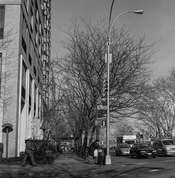Hello,
I would like to emulate (as close as possible) this picture's perspective
(taken with Rollei 6x6)
Would a 45mm equivalent 35mm lens at, say, f11 be able to adequately maintain this perspective (without compressing distances within the picture) ?
(the original article with the picture is at: https://www.texasgirlphotography.com/blog/2024/1/4/happy-new-year-heres-to-new-projects )
I have minolta 45mm f2 and Konica 40mm f1.8.
What I like about the picture, is that everything seems like I would see with my own eyes.
When I try to emulate similar look with 50mm I usually get a bit more compression, may be bit less detail and exposure range.
So I would like to try Ilford HP5 and Minolta 45mm at f11 to replicate / emulate the above.
Am I too far off ? and it is not going to be possible with the 35mm?
I would like to emulate (as close as possible) this picture's perspective
(taken with Rollei 6x6)
Would a 45mm equivalent 35mm lens at, say, f11 be able to adequately maintain this perspective (without compressing distances within the picture) ?
(the original article with the picture is at: https://www.texasgirlphotography.com/blog/2024/1/4/happy-new-year-heres-to-new-projects )
I have minolta 45mm f2 and Konica 40mm f1.8.
What I like about the picture, is that everything seems like I would see with my own eyes.
When I try to emulate similar look with 50mm I usually get a bit more compression, may be bit less detail and exposure range.
So I would like to try Ilford HP5 and Minolta 45mm at f11 to replicate / emulate the above.
Am I too far off ? and it is not going to be possible with the 35mm?







